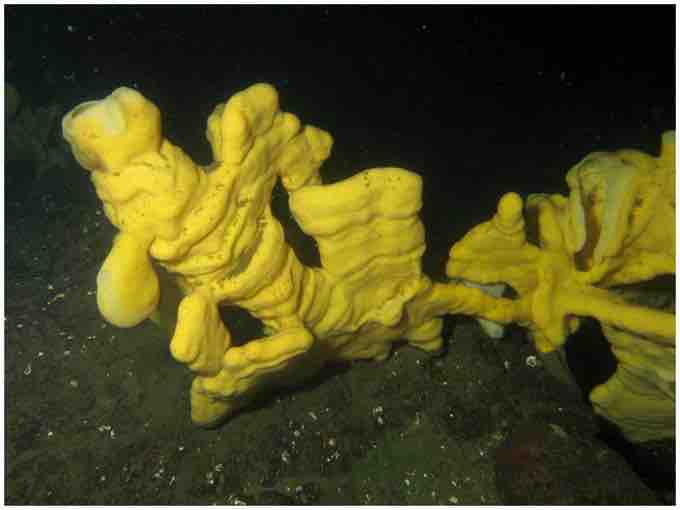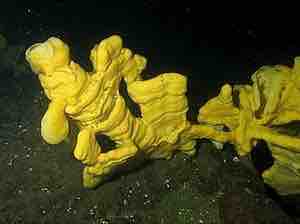Sponge reefs serve an important ecological function as habitat, breeding, and nursery areas for fish and invertebrates . The reefs are currently threatened by the fishery, offshore oil, and gas industries. Attempts are being made to protect these unique ecosystems through fishery closures, and potentially the establishment of Marine Protected Areas (MAPs) around the sponge reefs.

Aphrocallistes vastus
Aphrocallistes vastus (Cloud sponge), is a major reef-building species.
Hexactinellids
Hexactinellid sponge reefs were common in the late Jurassic period, and were believed to have gone extinct during or shortly after the Cretaceous period. Living sponge reefs were discovered in the Queen Charlotte Basin (QCB) in 1987-1988, and were reported in the Georgia Basin (GB) in 2005. These sponge reefs are considered to be "living fossils. "
Hexactinellids, or "glassy" sponges, are characterized by a rigid framework of spicules made of silica. Unlike other poriferans, hexactinellids do not possess the ability to contract. Another unique feature of glassy sponges is that their tissues are made up almost entirely of syncytia. In a syncytium there are many nuclei in a continuous cytoplasm; nuclei are not packaged in discrete cells.
As a result, the sponge has a distinctive electrical conduction system across its body. This allows the sponge to rapidly respond to disturbances, such as a physical impact or excessive sediment in the water. The sponge's response is to stop feeding. It will try to resume feeding after 20-30 minutes, but will stop again if the irritation is still present.
Hexactinellids are exclusively marine and are found throughout the world in deep (>1000 m) oceans. Individual sponges grow at a rate of 0-7 cm/year, and can live to be at least 220 years old. Little is known about hexactinellid sponge reproduction. Like all poriferans, the hexactinellids are filter feeders. They obtain nutrition from direct absorption of dissolved substances, and to a lesser extent from particulate materials. There are no known predators of healthy reef sponges. This is likely because the sponges possess very little organic tissue; the siliceous skeleton accounts for 90% of the sponge body weight.
Hexasterophorans
Hexasterophoran sponges have spicules called hexactines that have six rays set at right angles. Orders within hexasterophora are classified by how tightly the spicules interlock with Lyssanctinosan spicules less tightly interlocked than those of Hexactinosan sponges.
The primary frame-building sponges are all members of the order Hexactinosa, and include the species Chonelasma/Heterochone calyx (chalice sponge), Aphrocallistes vastus (cloud sponge), and Farrea occa. Hexactinosan sponges have a rigid scaffolding of "fused" spicules that persists after the death of the sponge.
Lyssactinosa
Other sponge species abundant on sponge reefs are members of the order Lyssactinosa (Rosselid sponges) and include Rhabdocalyptus dawsoni (boot sponge), Acanthascus platei, Acanthascus cactus and Staurocalyptus dowlingi. Rosselid sponges have a "woven" or "loose" siliceous skeleton that does not persist after the death of the sponge, and are capable of forming mats, but not reefs.
Sponge Reefs
Each living sponge on the surface of the reef can be over 1.5 m tall. The reefs are composed of mounds called "bioherms" that are up to 21 m high, and sheets called "biostromes" that are 2-10 m thick, and may be many km wide. Each sponge in the order Hexactinosa has a rigid skeleton that persists after the death of the animal. This provides an excellent substrate for sponge larvae to settle upon, and new sponges grow on the framework of past generations. The growth of sponge reefs is thus analogous to that of coral reefs. The tendrils of new sponges wrap around spicules of older, deceased sponges. The tendrils will later form the basal plate of the adult sponge that firmly anchors the animal to the reef.
Deep ocean currents carry fine sediments that are captured by the scaffolding of sponge reefs. A sediment matrix of silt, clay, and some sand forms around the base of the sponge bioherms. The sediment matrix is soft near the surface, and firm below one metre deep. Dead sponges become covered in sediment, but do not lose their supportive siliceous skeleton. The sponge sediments have high levels of silica and organic carbon. The reefs grow parallel to the glacial troughs, and the morphology of reefs is due to deep currents.
Hexactinellids first appeared in the fossil record during the late Proterozoic, and the first Hexactinosans were found in the late Devonian. Hexactinellid sponge reefs were first identified in the middle Triassic (245-208 million years ago). The sponges reached their full extent in the late Jurassic (208-146 million years ago), when a discontinuous reef system 7,000 km long stretched across the northern Tethys and North Atlantic basins. This chain of sponge reefs is the largest known biostructure to have ever existed on Earth.
